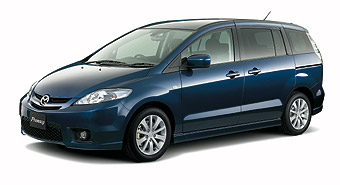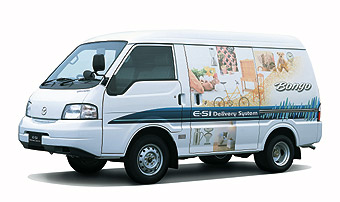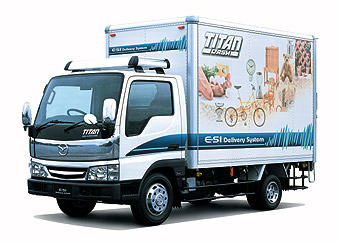A Minivan Offering Enjoyment and Comfort for the Whole Family: The All New Mazda Premacy to be Exhibited at the 38th Tokyo Motor Show- Mazda’s Show Theme: Sharing Zoom-Zoom - |
At the 38th Tokyo Motor Show*1, to be held from Tuesday November 2nd to Sunday November 7th at Makuhari Messe (Nippon Convention Center), Chiba Prefecture, Mazda Motor Corporation will be exhibiting the all new Mazda Premacy, a minivan in which Zoom-Zoom*2 enjoyment and functionality can be shared by the whole family. (Mazda plans to conduct the market launch of the new Premacy in spring 2005.) Mazda will also be showcasing other exciting developments. These include the Bongo Van Concept and Titan Dash Concept, each of which incorporates a system that enhances environmental protection and reduces work for delivery drivers. They also include environmental technologies in the form of the RENESIS hydrogen rotary engine, and the MZR-CD with DPF. And they include Mazda Smart Safety Technologies in the form of advanced driver-support systems. The theme of Mazda’s display is ‘Sharing Zoom-Zoom’, which expresses Mazda’s intention to extend to commercial vehicles and barrier-free vehicles the Zoom-Zoom values that are embodied in the new generation of Mazda products that began with the Mazda Atenza. Pursuing Zoom-Zoom benefits that all Mazda users can share is synergetic with Mazda’s fundamental goal of developing easy-to-use vehicles in a user-centered way. The overall benefit is a more expanded driving experience for everyone.
World debuted at Paris, the new Premacy is a minivan that represents a further evolution of Mazda Zoom-Zoom. It offers an environment that reflects a focus on comfort and communication for all occupants. At the same time, it offers functionality, dynamics, and maneuverability that enable anyone to use it enjoyably and easily for activities ranging from daily tasks to weekend leisure.
The Bongo Van Concept and Titan Dash Concept are new-concept delivery vehicles that each showcase Mazda’s Energy-Saving Idling Control (E-SI) Delivery System, which combines idle-stop functions with card-based keyless functions for greater environmental compatibility and driver convenience. The RENESIS hydrogen rotary engine is just one facet of Mazda’s efforts to realize vehicles that deliver Zoom-Zoom enjoyment in an environmentally responsible way. Capable of running both on hydrogen and on gasoline, it’s ideally suited to a future in which hydrogen availability for automobiles is steadily expanded. Mazda will also showcase a number of other exciting items such as advanced driver-support systems called Mazda Smart Safety Technologies that employ Intelligent Transportation Systems innovations, the MZR-CD with DPF (a diesel engine with which a catalyzed diesel particulate filter and other innovations realize a new standard of environmental compatibility together with strong running performance); barrier-free vehicles include a Mazda Verisa with a swivellable front passenger seat and a camper version of the Bongo Truck. Every exhibited vehicle and technology reflects Mazda’s determination to realize Zoom-Zoom benefits in forms that provide abundant enjoyment, comfort, and user-friendliness to an ever-growing number of drivers and passengers. Main Exhibits
Main Exhibits 1. Reference Exhibits All New Mazda Premacy (Japanese model) Following the Mazda Atenza, Mazda Demio, Mazda RX-8, and Mazda Axela, the new Premacy minivan is the latest stylish, insightful, and spirited model in Mazda’s new-generation lineup. Whereas the new-generation Mazda models launched thus far reflect a focus on expressing Mazda’s Zoom-Zoom spirit through spirited performance, the new Premacy’s designers focused on the insightful side of Mazda’s identity and thus evolved Mazda’s Zoom-Zoom values in an exciting new direction. Within a body whose size is easy to manage for any driver, the new Premacy offers an environment that reflects a focus on comfort and communication for all occupants. Most notably, a new ‘6+One’ packaging concept is reflected in a cabin layout with a central open space. The central space offers ‘+One’ value in various ways: It facilitates communication between people in the first, second, and third seating rows; it allows the use of a karakuri seat for a seventh person; and it allows the use of a karakuri storage box. The new Premacy also offers enjoyable performance, a refined ride, superior craftsmanship, and dynamic, stylish looks. In terms of enjoyment, comfort, and ease of use, it delivers a new kind of Zoom-Zoom experience that can be shared by the whole family. Bongo Van Concept / Titan Dash Concept The E-SI Delivery System’s idle-stop functions free the driver from having to use a key to stop and restart the engine. When the driver places the automatic shifter in the ‘P’ position and pulls the parking-brake lever, the engine is stopped. The first time the driver subsequently depresses the brake pedal, the engine is restarted. Since the engine is shut down every time the driver stops the vehicle to make a delivery, reduced exhaust emissions and fuel consumption promote environmental compatibility. Also, the driver enjoys the labor-saving benefit of not having to frequently stop and restart the engine using a key. The system’s card-based keyless functions save the driver from having to manually lock and unlock the doors. When the card key (carried by the driver) comes within a prescribed distance of the vehicle, the doors are unlocked. When the card key is carried away from the vehicle, the doors are locked. Since delivery work involves extremely frequent egress and ingress, the driver enjoys a welcome reduction in effort.
2. Technologies In developing the RENESIS hydrogen rotary engine, Mazda took advantage of its unique rotary-engine expertise to create a powerplant that runs cleanly while also delivering enjoyable performance. A dual-fuel system that incorporates a gasoline tank together with a high-pressure hydrogen tank is combined with the RENESIS hydrogen rotary engine, enabling it to run on gasoline when necessary (a convenient capability as an extensive hydrogen-supply infrastructure has yet to be constructed). Mazda continues its research and development toward the practical use of RENESIS hydrogen rotary engine. At the Tokyo Motor Show, hydrogen direct-injection system housing in a disassembled state as well as actual development scene are shown on the video. For the future, Mazda proposes to complement the RENESIS hydrogen rotary engine with various technologies. These include the Mazda Hybrid System, which stops the engine when the vehicle is stationary, uses an electric motor to boost torque when the engine is running at low speeds, and recovers braking energy and uses it to charge the battery. They also include an electric-motor-assisted turbocharger, which maximizes the effectiveness of forced induction at low engine speeds and thus enables lean combustion throughout the rev range. MZR-CD with DPF (Diesel Engine) Technologies including a common-rail system (this injects fuel at a high pressure of 180MPa (26,100psi) for superior combustion efficiency), an electronically controlled exhaust gas recirculation (EGR) system, and an EGR cooler realize exceptionally low nitrogen-oxide (NOx) emissions together with 10-15-mode fuel economy that’s approximately 13% better than that of earlier diesel engines. The engine also has a maintenance-free catalyzed diesel particulate filter. Here, a ceramic filter captures particulate matter (PM) and, when a certain amount of PM has accumulated, the PM is burned off to regenerate the filter. As a result, the engine enables compliance with new Japanese national legislation on NOx and PM emissions and with Tokyo Metropolitan Government regulations on diesel vehicles. Indeed, MZR-CD-equipped vehicles can be registered and driven in every region of Japan. Further, a turbocharger contributes to improvements of approximately 10% in maximum output and 30% in maximum torque over earlier diesel engines. <Mazda Smart Safety Technologies> Night Driving Aid System All-Round Blind-Angle Monitor System Lane Driving Aid System Pedestrian Protection Precrash Safety System Frontal Impact Precrash Safety System Rear Impact Precrash Safety System |



